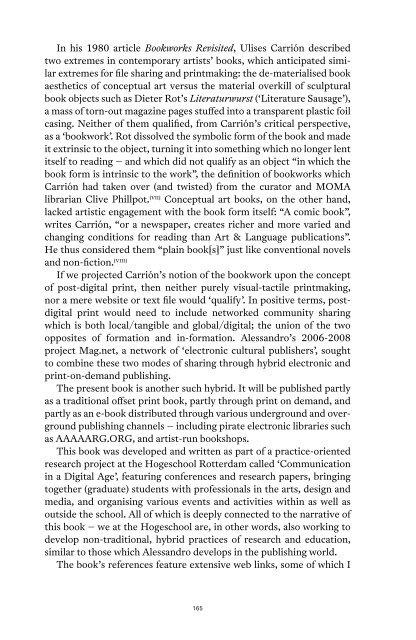Post- Digital Print - Monoskop
Post- Digital Print - Monoskop
Post- Digital Print - Monoskop
Create successful ePaper yourself
Turn your PDF publications into a flip-book with our unique Google optimized e-Paper software.
In his 1980 article Bookworks Revisited, Ulises Carrión described<br />
two extremes in contemporary artists’ books, which anticipated similar<br />
extremes for file sharing and printmaking: the de-materialised book<br />
aesthetics of conceptual art versus the material overkill of sculptural<br />
book objects such as Dieter Rot’s Literaturwurst (‘Literature Sausage’),<br />
a mass of torn-out magazine pages stuffed into a transparent plastic foil<br />
casing. Neither of them qualified, from Carrión’s critical perspective,<br />
as a ‘bookwork’. Rot dissolved the symbolic form of the book and made<br />
it extrinsic to the object, turning it into something which no longer lent<br />
itself to reading – and which did not qualify as an object “in which the<br />
book form is intrinsic to the work”, the definition of bookworks which<br />
Carrión had taken over (and twisted) from the curator and MOMA<br />
librarian Clive Phillpot. [vii] Conceptual art books, on the other hand,<br />
lacked artistic engagement with the book form itself: “A comic book”,<br />
writes Carrión, “or a newspaper, creates richer and more varied and<br />
changing conditions for reading than Art & Language publications”.<br />
He thus considered them “plain book[s]” just like conventional novels<br />
and non-fiction. [viii]<br />
If we projected Carrión’s notion of the bookwork upon the concept<br />
of post-digital print, then neither purely visual-tactile printmaking,<br />
nor a mere website or text file would ‘qualify’. In positive terms, postdigital<br />
print would need to include networked community sharing<br />
which is both local/tangible and global/digital; the union of the two<br />
opposites of formation and in-formation. Alessandro’s 2006-2008<br />
project Mag.net, a network of ‘electronic cultural publishers’, sought<br />
to combine these two modes of sharing through hybrid electronic and<br />
print-on-demand publishing.<br />
The present book is another such hybrid. It will be published partly<br />
as a traditional offset print book, partly through print on demand, and<br />
partly as an e-book distributed through various underground and overground<br />
publishing channels – including pirate electronic libraries such<br />
as AAAAARG.ORG, and artist-run bookshops.<br />
This book was developed and written as part of a practice-oriented<br />
research project at the Hogeschool Rotterdam called ‘Communication<br />
in a <strong>Digital</strong> Age’, featuring conferences and research papers, bringing<br />
together (graduate) students with professionals in the arts, design and<br />
media, and organising various events and activities within as well as<br />
outside the school. All of which is deeply connected to the narrative of<br />
this book – we at the Hogeschool are, in other words, also working to<br />
develop non-traditional, hybrid practices of research and education,<br />
similar to those which Alessandro develops in the publishing world.<br />
The book’s references feature extensive web links, some of which I<br />
165

















